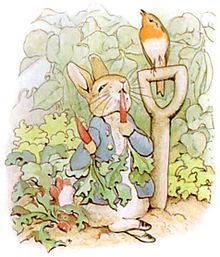
Peter Rabbit
About this schools Wikipedia selection
SOS Children, an education charity, organised this selection. See http://www.soschildren.org/sponsor-a-child to find out about child sponsorship.
Peter Rabbit is a fictional anthropomorphic character in various children's stories by Beatrix Potter. He first appeared in The Tale of Peter Rabbit in 1902, and subsequently in five more books between 1904 and 1912. Spinoff merchandise includes dishes, wallpaper, and a doll. He appears as a character in the 1971 ballet film, The Tales of Beatrix Potter, in an animated episode of the BBC anthology series, The World of Peter Rabbit and Friends.
Background
The rabbits in Potter's stories are anthropomorphic and wear human clothes; Peter wears a jacket and shoes. Peter, his mother, Mrs. Josephine Rabbit, and his sisters, Flopsy, Mopsy, and Cotton-tail live in a rabbit hole that has a human kitchen, human furniture, and a shop where Mrs. Rabbit sells various items. Peter's relatives are cousin Benjamin Bunny and Benjamin's father Mr. Benjamin Bunny.
Peter Rabbit was named after a pet rabbit Beatrix Potter had as a child called Peter Piper. The first Peter Rabbit story, The Tale of Peter Rabbit, was originally created in 1893 as a letter to Noel Moore, the five-year-old son of Potter's former governess, Annie Moore. The boy was ill, and Potter wrote him a picture and story letter to help him pass the time and to cheer him up. The letter included sketches illustrating the narrative.
In June 1902, a trade edition of the tale was published by Frederick Warne & Co, and by the end of the year, 28,000 copies were in print. Over the years, The Tale of Peter Rabbit has sold more than 40 million copies worldwide and as of 2008, the Peter Rabbit series has sold more than 151 million copies in 35 languages.
Books
Peter Rabbit made his first appearance in 1902 in The Tale of Peter Rabbit. Peter disobeys his mother's orders and sneaks into Mr. McGregor's garden, eating as many vegetables as he can before Mr. McGregor spots him and chases him about. Peter manages to escape, but not before losing his jacket and shoes, which Mr. McGregor uses to dress a scarecrow. Peter returns home weary and ill and is put to bed with a dose of camomile tea.
In The Tale of Benjamin Bunny, first published in 1904, Peter's cousin Benjamin Bunny brings him back to Mr. McGregor's garden and they retrieve the clothes Peter lost in The Tale of Peter Rabbit. But after they gather onions to give to Peter's mother, they are captured by Mr. McGregor's cat. Benjamin's father arrives and rescues them, but also reprimands Peter and Benjamin for going into the garden by whipping them with a switch. In this tale, Peter displays some trepidation about returning to the garden.
In The Tale of the Flopsy Bunnies, first published in 1909, Peter has a small role and appears only briefly. He is grown up and his sister Flopsy is now married to his cousin Benjamin Bunny. The two are the parents of six little Flopsy Bunnies. Peter and his mother keep a nursery garden and the bunnies come by asking him for spare cabbage.
In The Tale of Mr. Tod, first published in 1912, Benjamin and Flopsy's children are kidnapped by notorious badger Tommy Brock. Peter helps Benjamin chase after Brock, who hides out in the house of the fox Mr. Tod. Mr. Tod finds Brock sleeping in his bed and as the two get into a scuffle, Peter and Benjamin rescue the children.
Peter makes cameo appearances in two other tales. In The Tale of Mrs. Tiggy-Winkle, first published in 1905, Peter and Benjamin are customers of Mrs. Tiggy-Winkle, a hedgehog washerwoman. The two rabbits are depicted in one illustration peeping from the forest foliage. In The Tale of Ginger and Pickles, first published in 1909, Peter and other characters from Potter's previous stories make cameo appearances in the artwork patronising the shop of Ginger and Pickles.
Merchandising
Potter created a soft doll depicting Peter Rabbit and a Peter Rabbit board game shortly after the tale's first publication. The character has been depicted in a multitude of spinoff merchandise such as porcelain figurines and dishes. Peter Rabbit also appears on the packaging of the infant formula Enfamil.
Peter Rabbit was the first soft toy to be patented, in 1903, making Peter the oldest licensed character. Frederick Warne & Co owns the trademark rights of the Beatrix Potter characters. However, most of the stories are in the US public domain, as they were published before 1923.
Adaptations
Several of the stories featuring Peter Rabbit were animated for the 1992 BBC anthology series, The World of Peter Rabbit and Friends. Peter Rabbit appears in the 1971 ballet film, The Tales of Beatrix Potter.


